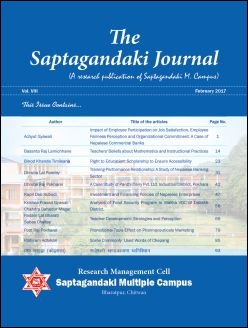Training-performance relationship: A Study of Nepalese Banking Sector
DOI:
https://doi.org/10.3126/sj.v8i0.18460Keywords:
training, performance, turnover growth, business survival, firm size, technologyAbstract
Training is one of the dominant techniques of management development program in modern organizations. Substantial number of studies on human resource management literature focuses the relationship between training and employee performance with its broader implication on organizational growth and profitability particularly the training effect in gaining sustained competitive advantages. This study aims to test the hypothesized relationship of training and organizational performance in Nepalese banking sector. A survey design approach was applied. Ten commercial banks were selected randomly and 230 respondents from various banks participated in the survey. Likert scale questions were used for getting responses. Multiple regression analysis, ANOVA, and simple descriptive statistics were used for data analysis. All training techniques taken individually and in group (formal, informal) were regressed on turnover growth. The study result confirmed that the both incidence and intensity of training has strong effect on organizational performances particularly the turnover growth. Interestingly the study found that the firms investing predominantly in formal training better performed than those relying on informal training. However, the firm size, organization structure and technology have moderating effect on training-performance relationship stressing for requisites of further research to confirm the cross sectional validity of findings rather than to its early generalizations.
The Saptagandaki Journal Vol.8 2017: 31-41
Downloads
Downloads
Published
How to Cite
Issue
Section
License
© The Saptagandaki Journal
The author of article must sign the copyright permission or the author must assign copyright to the Journal/to the Campus Authority prior to publication.
All rights reserved.




